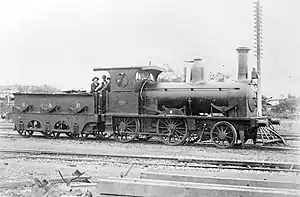| South Australian Railways C Class | |||||||||||||||||||||||||||||||||||||||||||
|---|---|---|---|---|---|---|---|---|---|---|---|---|---|---|---|---|---|---|---|---|---|---|---|---|---|---|---|---|---|---|---|---|---|---|---|---|---|---|---|---|---|---|---|
 South Australian Railways C Class No. 6 | |||||||||||||||||||||||||||||||||||||||||||
| |||||||||||||||||||||||||||||||||||||||||||
| |||||||||||||||||||||||||||||||||||||||||||
| |||||||||||||||||||||||||||||||||||||||||||
| |||||||||||||||||||||||||||||||||||||||||||
The South Australian Railways C Class locomotives were built by the Robert Stephenson and Company for the South Australian Railways in 1856. The first locomotive (No. 5) was in service by November 1856, with the second engine (No. 6) in service by January 1857. They were both withdrawn after long service lives, with No. 5 being withdrawn after 50 years working on the SAR. No. 6 lasted well into Commissioner Webbs era, finally being withdrawn in 1926 at almost 70 years old.[1]
History
Since the South Australian Railways had the new B class tank engines built to run on the railway line to Gawler, two more locomotives were purchased to also run this service on the lightly laid route. These locomotives were designated the "C class" and their range was increased to include stops at Roseworthy and Kapunda due to the opening of the new line extension on 13 August 1860. The C Class was later used the construction of the Tarlee line. In 1884 and 1885, both locomotives were rebuilt and put back into traffic, having acquired new cabs which were complete with circular front and side windows.
The C Class worked on the northern lines until they were superseded by more powerful locomotives. No. 5 was condemned in 1906 at the age of 50 years, while No. 6 continued to work on the suburban system and performed shunting duties at Mile End and Port Adelaide. No. 6 was eventually withdrawn and scrapped in 1926, after 70 years of service.[2][3]
References
- ↑ TURNER, JIM (1998). EARLY AUSTRALIAN STEAM LOCOMOTIVES 1855-1895. South Australia: Kangaroo Press. p. 112. ISBN 0-86417-875-1.
- ↑ FLUCK, R. E.; SAMPSON, R.; BIRD, K. J. (1986). STEAM LOCOMOTIVES AND RAILCARS OF THE SOUTH AUSTRALIAN RAILWAYS. South Australia: Mile End Railway Museum (S.A.) Inc. pp. 40–41. ISBN 0959 5073 37.
- ↑ Drymalik, Chris. "Broad Gauge C-class 2-4-0 locomotives". Chris's Commonwealth Railways Information (ComRails). Retrieved 30 July 2019.